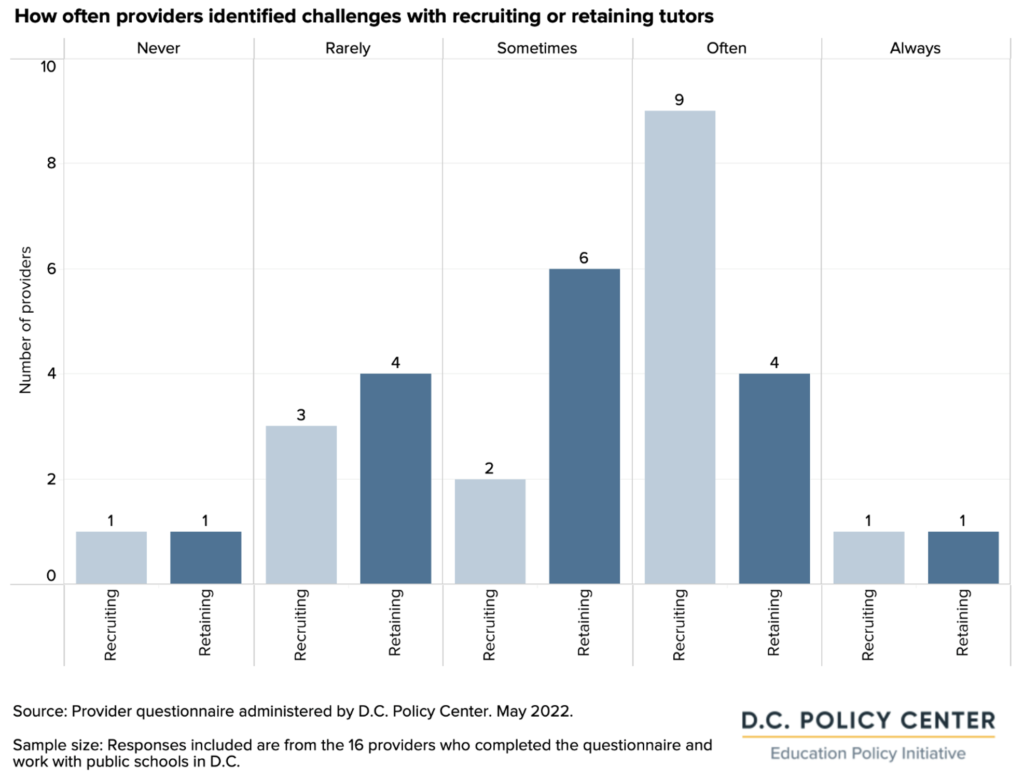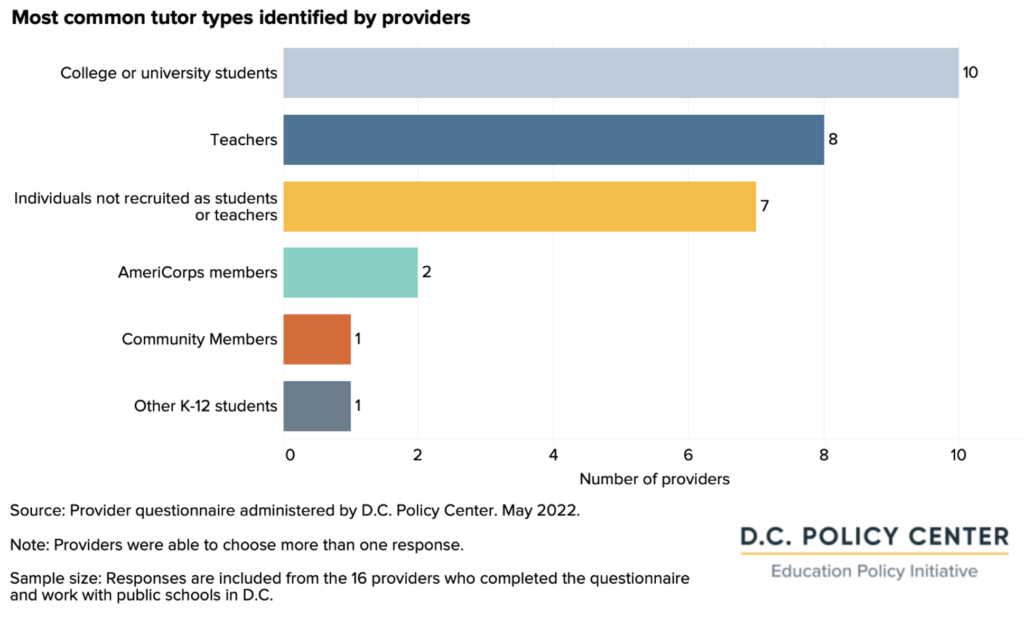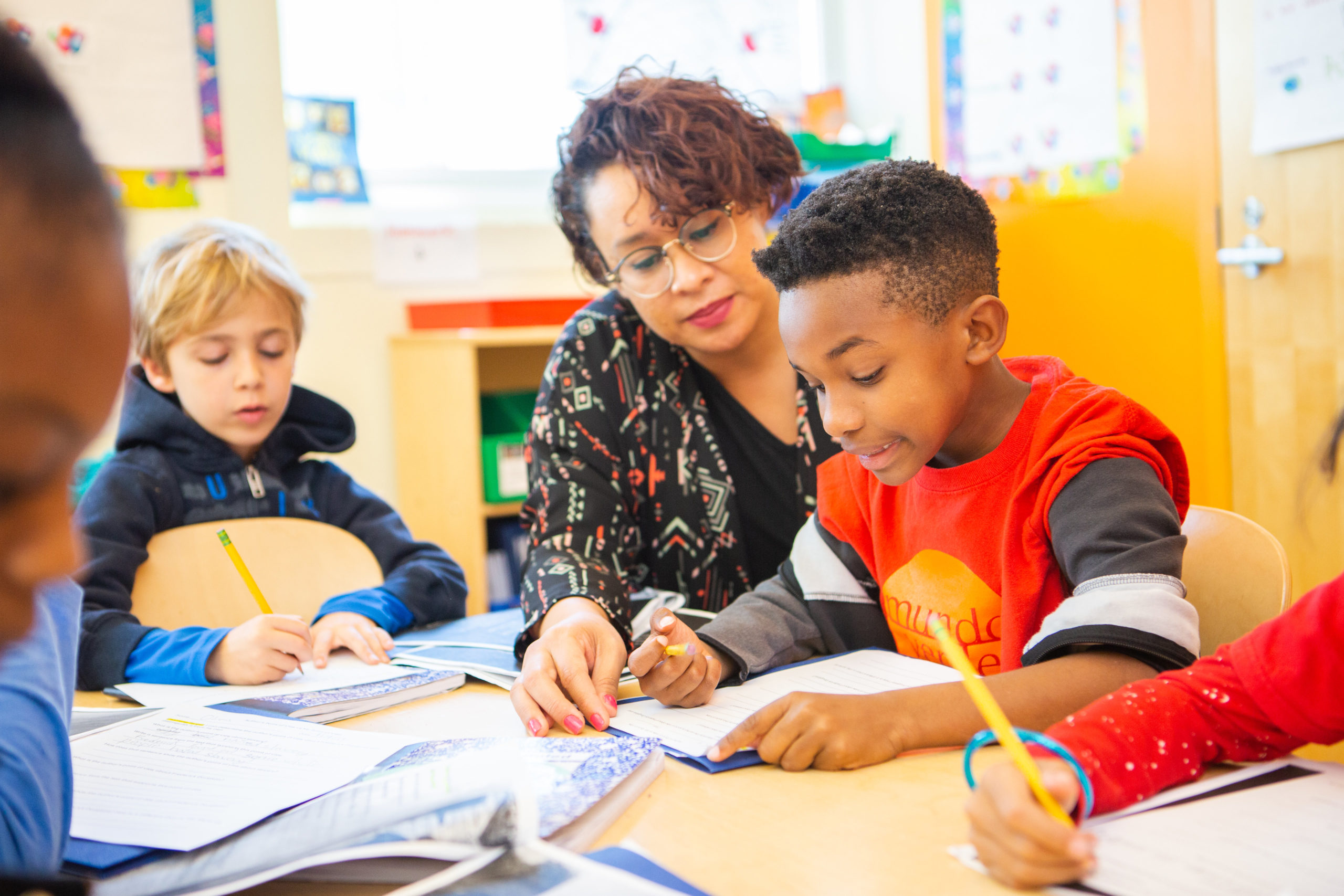

In our report released last week, Landscape of high-impact tutoring in D.C.’s public schools, 2021-22, we examined how D.C. approached high-impact tutoring (HIT) as one strategy to accelerate learning following a year of virtual instruction due to COVID-19. This type of tutoring aligns with research-backed guidelines and is concentrated, consistent, and stresses the importance of building strong tutor-student relationships.
The first year of HIT implementation was filled with learning opportunities and challenges for LEAs, providers, systems-level actors, and the tutors themselves. As HIT continues to scale in school year 2022-23, it is important to take stock of provider, tutor, and teacher experiences and challenges during the first year of HIT.
In this latest installment in our D.C. Voices series, we hear directly from tutoring providers, tutors, and teachers involved with HIT to learn more about the day-to-day realities of HIT particularly around strengthening tutor-student relationships, what changes are being implemented during this school year, and where they see the program going forward.
In our report released last week, Landscape of high-impact tutoring in D.C.’s public schools, 2021-22, we examined how D.C. approached high-impact tutoring (HIT) as one strategy to accelerate learning following a year of virtual learning due to COVID-19.
HIT is a type of tutoring characterized by its consistency, intensity, and quality of tutor preparation. These types of tutoring programs have been found to be an effective strategy to improve student achievement.1 In addition to elements that are often present in HIT—such as time spent per week, sessions per week, use of assessments, tutor training, and alignment with school curriculum—effective programs have a stated focus on cultivating tutor-student relationships.2 When designing guidelines for HIT implementation in D.C., OSSE and CityTutor D.C.—a coalition of schools, community-based organizations, civic partners, and other stakeholders—both included this element as part of their definition.
In order to cultivate tutor-student relationships, best practices dictate that tutors should work with the same students week-to-week in order to build trust and communication. All 16 HIT providers partnering with public schools in D.C. who responded to a D.C. Policy Center questionnaire3 said that tutors involved in their programs either often or always worked with the same group of students week-to-week–indicating that these programs are also prioritizing building relationships.
While a strong and consistent tutor workforce is a priority for HIT, it can be difficult to recruit and retain high-quality tutors. The D.C. Policy Center questionnaire found that providers who responded were most likely to say that they rank recruiting tutors as more challenging than retaining them. While it may be difficult to fill tutoring positions, once tutors are engaged with providers it seems more likely that they will stay with a particular program and provide consistent services.


One possible way to mitigate challenges associated with recruitment is by having teachers provide tutoring services. Local Education Agencies (LEAs) that provide tutoring services in-house, meaning that they coordinate and manage the program using school staff, have found some success by training teachers on how to provide HIT and engaging them in tutoring services. Tutoring providers who responded to the D.C. Policy Center questionnaire also identified teachers as a common tutor type, trailing only college and university students as the most common tutor type.


The first year of HIT implementation was filled with learning opportunities and challenges for LEAs, providers, systems-level actors, and tutors themselves. As HIT continues to scale in school year 2022-23, it is important to take stock of provider, tutor, and teacher experiences and challenges during the first year of HIT. In order to find out more about the day-to-day realities of HIT, particularly around strengthening tutor-student relationships, in D.C. last year and what changes are being implemented during this school year, the D.C. Policy Center reached out to providers, tutors, and teachers involved with HIT to ask more what their experience with HIT was during the 2021-22 school year, what changes they’ve witnessed with the program, and where they see the program going forward.
Claice Jackson, Director of Programs, Washington, D.C., Saga Education
Though originally unplanned, the hybrid model was successful, thanks to the support and collaboration of our partner schools and Saga staff and AmeriCorps members in D.C. As the year went on in anticipation of possible future staffing issues, we worked to continually improve this model to implement it more efficiently this school year.
The 2021-22 school year marked Saga Education’s third year of partnership with DC Public Schools (DCPS), when we provided high-dosage math tutoring to 360 ninth and tenth graders across the district. We work with students during a defined block within their school day through Saga’s blended learning model, where an adaptive learning platform supports small group instruction from a talented AmeriCorp math tutor.
While Saga celebrated many student successes, the 2021-22 school year also presented some challenges, including concerns from staff and students as they re-entered school sites while navigating a pandemic. Consequently, these concerns led to challenges in staffing in-person tutors and pushed us to brainstorm solutions to address them. Saga responded by introducing a hybrid model where we brought on remote tutors in order to supplement in-person tutors. Until that point, our program in D.C. had always been implemented with a fully in-person team including a Site Director and an in-person team of AmeriCorp Fellows. This new staffing challenge allowed Saga to try something new and innovate the way that we serve students by offering a mix of virtual and in-person tutoring.
Though originally unplanned, the hybrid model was successful, thanks to the support and collaboration of our partner schools and Saga staff and AmeriCorps members in D.C. As the year went on in anticipation of possible future staffing issues, we worked to continually improve this model to implement it more efficiently this school year.
The implementation of our program has changed from school year 2021-22 to the current school year. OSSE’s High-Impact Tutoring Grant has allowed the Saga program to double its impact, and we are now serving 720 ninth and tenth grade DCPS students. Additionally, Saga continues to respond to staffing challenges, particularly for the in-person AmeriCorps Fellow role. We’ve implemented the online model at two of our partner schools, where each Fellow works with one to three students at a time in Saga Connect, our virtual tutoring platform. Students at the school continue to have the in-person support of their Site Director, as well as a Learning Coordinator who works with students on the blended learning platform. Additionally, the small student groups promote collaborative peer learning, which positively supports students’ achievement, persistence, and attitudes, and provides them with opportunities to take responsibility for their own as well as their peers’ learning.
Going forward, Saga will continue to collaborate with our current DCPS high school partners to strengthen the impact that our program has built. We look to maintain our current partnerships and we are open to the possibility of further expansion within the district. Regardless of how our model may adapt to address an ever changing education landscape, Saga remains committed to research-backed curriculum, acute program oversight, strategic data analysis, and the best quality tutorials for DC scholars.
Cherrye Jeter, Tutor, RISE D.C.
The frequency and duration through the R.I.S.E. HIT model efficiently supported students at their individual levels and allowed tutors to put in place necessary scaffolds and supports that resulted in increased scores and grades.
During the 2021-22 school year, I worked as a tutor with R.I.S.E. DC. I was assigned to both E.L. Haynes and Roosevelt STAY High School delivering high-impact tutoring (HIT) services. The R.I.S.E. model is unique; most of our tutors are embedded in the classrooms with our tutees. This allows us to get a firsthand account of content and expectations. R.I.S.E. is also unique because the organization has been providing HIT free of charge to students for over 19 years, long before the term began trending.
A typical day for me during the 2021-22 school year was to arrive at the school and clear the COVID protocols, enter my assigned classroom and dive in to support the students identified on my caseload. We typically worked within the classroom at the small group table, but there were many times when I took students to other rooms to minimize distractions. Working with groups of no more than four students, we would meet daily or every other day depending on the schedule. Having previously tutored through a traditional afterschool model, the 2021-22 school year really gave me the opportunity to see the immeasurable benefits of HIT. The frequency and duration through the R.I.S.E. HIT model efficiently supported students at their individual levels and allowed tutors to put in place necessary scaffolds and supports that resulted in increased scores and grades.
Last year was full of surprises. First, much valuable instructional time has been recovered with the easing of COVID restrictions. In general, students were quite active and eager to socialize with peers, which is totally understandable after the long COVID isolation period. This year feels a lot more like a regular school year. Less time needs to be spent on addressing behavioral issues or allowing for time to socialize. Another big change has been the move to delivering almost all our services in-person. Last year, 30 percent of tutees on my caseload received virtual services. This year, we have very few students receiving virtual services in the program overall. Additionally, entering the 2021-22 school year, there was limited data on students’ levels of performance as they did not participate in standardized assessments during the prior two years. With the lack of data, tutoring groups were not always consistent, especially earlier in the school year. Teachers, administrators and tutors made changes frequently as we learned more about the student’s needs. I feel like much of last year was spent collecting data while getting students reacclimated to the school environment. This year feels more intentional.
The pandemic has further exposed the need for not just programs like HIT but for more robust mental health services for our youth. When students returned from long term isolation so many soft skills were lost. Moreover, many students developed significant mental health issues. In order to raise scores and grades and to begin to minimize the achievement gap and address the pandemic learning loss, our students must feel safe and feel seen. In the future, I see R.I.S.E. DC continuing to provide Resources to Inspire Students and Educators through the expansion of mental health programming that will support the overall development of our students.
Jaime Solano Cardoso, teacher, Oyster-Adams Bilingual School
Not only did their grades and test scores grow, but [students] also increased their self-confidence, which helped them to be more involved in their classes and increase their participation. The tutoring not only increased their knowledge, but also helped them reconnect with the school and recognize the potential that they had.
After a year of virtual education for most students in DC Public Schools, students returned to the classroom bringing with them different lived and learning experiences. To ensure that each student had the necessary support to thrive following the year of virtual education, schools implemented different strategies, such as HIT. Under HIT, teachers identified four to five students who could benefit from having after-school support with a teacher in a small group setting. Teachers took into consideration the students’ academic data collected from assessments, observations, and overall performance to create these small groups.
I must admit that, at first, I thought that HIT’s focus was simply academic, but very quickly I discovered that the support provided to students was much more than academic. Students were returning to classes in person, displaying enthusiasm to reconnect with the school. In a smaller environment, the students had the possibility to strengthen relationships with other students and their teacher. I remember that on multiple occasions, the students talked about their personal lives during tutoring, or we laughed about something that happened at home or at school. The tutoring group became a small community of friends that celebrated each other’s academic effort and growth. By meeting in a smaller group, unlike regular classes that exceed 20 students, each student participated and gave their opinion many more times than they did during the school day. Not only did their grades and test scores grow, but they also increased their self-confidence, which helped them to be more involved in their classes and increase their participation. The tutoring not only increased their knowledge, but also helped them reconnect with the school and recognize the potential that they had.
As we are beginning a new school year, we recognize that the academic needs persist and will remain committed to support students to increase their confidence and help discover the potential each student has to grow academically and personally. HIT’s experience last year confirms the need to continue providing this support to our students, which requires continued and increased support from DCPS to the schools and teachers.
Tiffany Petrov, MTSS Intervention Coach, Anne Beers Elementary School
HIT is designed to meet the students where they are yet put a success plan in place to accelerate and propel them forward academically.
HIT is a proven academic recovery strategy educators use to help our students who are performing multiple years below grade level. We implement the intervention of HIT at the beginning of the school year to supply immediate response to the needs of students. HIT is considered a Tier 3 intervention within the Multi-Tiered System of Supports that we have in place to address the needs of the whole child.
Determining students’ eligibility for high impact tutoring is data driven. Educators examine the student data wholistically looking at multiple data points in each academic subject as well as attendance, social-emotional data and behavior data. For example, teachers will examine several English Language Art’s assessments such as Achievement Network (ANET), Reading, Reading Inventory, and iReady Reading. For mathematics data, educators review ANET Math, iReady Math, and Required Curriculum Task (RCTs). The data provide the educator with the insight to plan and prepare to administer targeted instruction to the student’s academic areas most in need of accelerated learning. Students receive a minimum of 90 minutes (about 1 and a half hours) per week of intense targeted instruction and students’ progress is monitored biweekly.
Progress monitoring is necessary to determine students’ growth as well as to adjust instruction if needed. All student interventions plans are created and tracked in our school data platform, Panorama. High impact tutoring is an efficient and effective intervention to address students’ academic needs.
This year, HIT was up and running quickly and more efficiently. From our experience last year, we learned it is necessary to have systems and structures in place to ensure that HIT runs smoothly. For instance, HIT occurs 1:1 or in small groups of up to 1:4. Instruction is delivered by consistent tutors for the duration of the intervention and the tutor consistently monitors student progress. I believe this program will continue to grow and expand. As we serve the whole child, with the understanding all students have different learning profiles, individualized learning plans are necessary to help children who are not meeting grade level expectations. HIT is designed to meet the students where they are yet put a success.
Endnotes
- J-PAL Evidence Review. 2020. “The transformative potential of tutoring for PreK-12 learning outcomes: Lessons from randomized evaluations.” Abdul Latif Jameel Poverty Action Lab. Retrieved from https://www.povertyactionlab.org/sites/default/files/publication/Evidence-Review_The-Transformative-Potential-of-Tutoring.pdf
- The National Student Support Accelerator of the Annenberg Institute at Brown University works to translate the research on HIT into actionable items to help implement HIT. They have identified the characteristics included in their analysis of effective HIT programs. Source: National Student Support Accelerator. 2022. Toolkit for tutoring programs. Retrieved from https://studentsupportaccelerator.com/tutoring
- The D.C. Policy Center distributed a questionnaire to tutoring providers, LEAs, schools, and central agencies inquiring about tutors, students, tutoring sessions, and reflections on implementation. The questionnaire was circulated in May and June of 2022. For more information on the questionnaire, methodology, and findings, see Landscape of high-impact tutoring in public schools, 2021-22.
